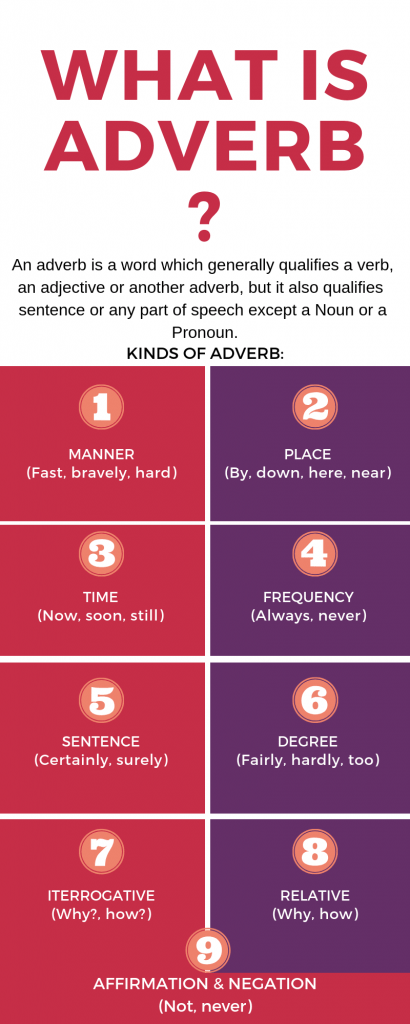Adverb in English Grammar with Examples [PDF]
In this article, you will be going to learn what is Adverb in English Grammar? and also you are going to learn the types of adverb and their examples.

Definition of Adverb:
An adverb is a word used to add something to the meaning of a verb, another adverb, and, an adjective. It is used to modify adjectives, verbs, and adverb. When you are talking about a situation or an event, sometimes you want to say something about it which has not been indicted by the subject, object or complement, verb. You can do this by using an adjunct.
An adjunct is a word or group of words which you add to a clause when to say something about an event or situation. For example, how much it occurs or where it occurs?
For example:
- She laughed quietly.
- jack is walking slowly.
- He is walking very slowly.
- She was tremendously beautiful.
On the next, I will show you the types of Adverb.
TAKE A LOOK ON THIS INFOGRAPHIC

Types of Adverb:
There are 9-types of Adverb and those are:
- Adverb of Time– Soon, ago, before, lately, yet, then, today.
- Adverb of Manner– So, bravely, hard, happily, soundly.
- Relative Adverb – How, why, where, when.
- Adverb of Frequency– Rarely, never, always, seldom, usually, occasionally, twice, never, often.
- Adverb of Sentence– Surely, luckily, certainly.
- Interrogative Adverb– Why? when? how?
- Adverb of Degree– rather, too, really, very, fully, hardly, fairly, quiet.
- Adverb of affirmation and negation– Undoubtedly, certainly, never, not, apparently, obviously, no.
- Adverb of Place– Upward, backward, everywhere, down, near, away, here, by, down, there.

Adverb of Manner:
Adverbs of manner come after a verb. For example, Lilly dance beautifully.
In another case, it is used after the object when there is one. For example, He gave her the money reluctantly.
When in a sentence we have verb + preposition + object, an adverb is used either before the preposition or after the object. For example, Sam looks at me suspiciously or he looked suspiciously at me.
Adverb of Frequency:
Always, frequently, often, once, twice, periodically, sometimes, continually, etc.
Ever, seldom, rarely, scarcely, hardly
Adverbs are above placed in a sentence in two ways like:
After the simple tenses of to be. For example, he is always in time for play.
Before the simple tense of all other verbs. For example, they sometimes stay up all night.
In compound tenses, adverbs are placed after the first auxiliary verbs or interrogative verbs, after auxiliary + subject. For example, you have often been told not to do this.
Adverb of Place:
If in a sentence there is no subject then adverbs are usually placed after the verb. For example, He lives abroad.
But they come after Verb + object / verb + preposition + object. For example, I looked for it everywhere.
Adverb phrases formed preposition + noun or pronoun or adverb. For example, He stood in the doorway.
Adverb of Time:
This type of adverbs is usually placed at the very beginning or at the very end of the clause (front position or end position). For example: Eventually, he came/he came eventually.
Adverb of degree:
It modifies an adjective or adverb. It placed before an adjective or adverb. For example, you are absolutely right.
But enough follows its adjective or adverb. For example, the car is not big enough.
Interrogative Adverb:
For example:
- How did you do this?
- Why are you sorry?
Relative Adverb:
It is used to make the Adjective Clause. For example, Adrian does not like to stay at the hotel where they are staying.
Adverb of Affirmation and Negation:
For example:
- I will certainly go to school.
- I have never seen him.
Rules of Adverb:
Rule 1
Adverb of manner (Slowly, quickly), adverb of place (here, there), and adverb of time (now, then, today, yesterday, tomorrow) are used after a verb.
For example,
- He came here yesterday.
Rule 2
MPT rule:
- Adverb of Manner.
- Adverb of Place.
- Adverb of Time.
For example,
- She sang a song sweetly (M) there (P) yesterday (T).
Rule 3
PMT rule:
In case of an action verb (come, go, reach, arrive) this rule is followed.
For example,
- They went there (P) happily (M) yesterday (T).
Rule 4
Adverb of frequency (often, seldom, ever, never, always) is used before a verb.
For example,
- Always speak the truth.
Rule 5
Use of else and other, ‘Else’ should be followed by ‘but’.
‘Other’ and ‘otherwise’ are followed by ‘then’.
For example,
- It is nothing else than sheer madness. (use ‘but’ in place of ‘then’).
- She had no other alternative but stay here. (use ‘then’ in place of ‘ but’).
- She has no one else to look after her expect me. (use ‘but’ in place of ‘ except’).
Rule 6
Both ‘never’ and ‘not’ the adverbs. The use of ‘never’ for ‘not’ is incorrect.
For example,
- I never want to sooty last year (use ‘did not’ go in place of ‘never’).
- I remember never to have said so (correct).
- I never allow my son to go out in dark (correct habitual action).
Rule 7
‘Enough’ is an adverb and it is used after an adjective or another adverb.
For example,
- He is brave enough to do this.
Rule 8
Both direct and directly are adverbs. Direct is used after a verb and directly is used before a verb.
For example,
- The train directly goes to Delhi.
- The train goes to Delhi direct.
Rule 9
Both hard and hardly are an adverb. Hard is used in a positive sense and hardly is used in a negative sense.
For example,
- Save your hard earned money.
- Hardly had he reached when they left.
Rule 10
Enough is an adverb and it is used after an adjective or another adverb.
For example,
- He is brave enough to do this.
Rule 11
More firstly and more highly are incorrect. Faster and higher are used in place of them.
For example,
- He runs faster than I.
Rule 12
‘Very’ is used with the present participle (V1 + Ing).
For example,
- His speech was very inspiring.
Rule 13
‘Ago’ is used with definite time and ‘before’ is used with indefinite time.
For example,
- I saw him five years ago.
- They had come before I came.
Rule 14
Noun + ly = Adjective.
For example,
- Love + ly = Lovely.
- Friend + ly = Friendly.
Adjective + ly = Adverb.
For example,
- Slow + ly = Slowly.
- Swift + ly = Swiftly.
Rule 15
‘Yet’ means ’till now’ when it is used as adverb.
For example,
- The criminal has not been found yet.
- The criminal is yet to be found.
A Must Watch Video Lesson on Adverb:
Exercise on Adverb:
Put the words in the brackets at the proper place
- I go there (never, seldom).
- She has left the place (already).
- He supports me(always).
- The boy has done his part (well).
- I have seen him (often).
- She has gone home (already).
- He talks too much (sometimes).
- He is active (very).
- She comes in time (always).
- He has examined the case (already).
If you like our lesson on Adverb, do share it in your social handling and with your friends. And also comment down answers of the above questions, I will check and correct those for you.
References [External Links:
- Adverb phrases – English Grammar Today
- English Grammar Adverb Rules with Examples – EduDose